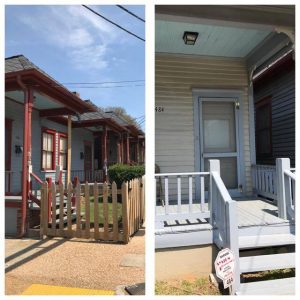
Shotgun Houses at Auburn Av as a historic landmark
My research for the Auburn Av. project focused on the historic Shotgun houses in Atlanta. They were very iconic and prominent in the 1900’s, having been originally occupied by white blue collar workers, and then the growing African American population, which would eventually mostly inhabit these houses. It was interesting to see the structure of the houses, which showed a lower standard of living, but also held a sort of community and culture givent that they all looked the same and were so accessible for everyone in the neighbourhood. Nowadays the houses have not been removed, and stay as a historic site of the Civil Rights Movement, they are kept in stable conditions, and there is actually a landmark sign that describes them.
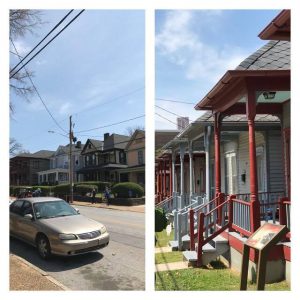
Shotgun houses right across the street from Upper class African American family houses such as MLK’s
Whilst doing my research on the houses, I was not fully aware of the surrounding conditions, for which when we got there we saw that right across the street were the houses of the upper class African American families, including MLK Jr’s. It gave a bigger sense of the neighbourhood and the African American community as a whole, given that two distinct social classes were situated in the very same place. Moreover, given the status of the place as a landmark, it was kept in stable and good conditions for tourists, for which gentrification did not take over and change the place, but rather preserved it as a historical attraction that generates tourism.
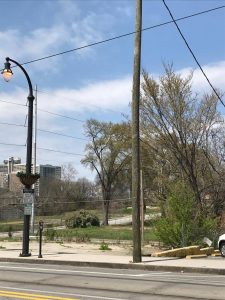
Empty Lots that used to house urban farms
As we were walking down the street, and once we passed the main historic site next to the MLK museum, I noticed that there were very few buildings around, and there were in fact some empty lots that seemed completely abandoned without any real construction in them (as seen in the picture). We were told that a lot of these lots were used for urban farming, but were taken down a few years ago. I found this interesting on how the process of gentrification develops in one specific part of the area. Whoever is investing in Auburn Av first had to get rid of these urban farms, and could now (although I do not know the information for sure) be working towards developing the land to be able to build some sort of infrastructure that betters the neighbourhood. In itself, gentrification cannot happen from day to night, and it takes time and effort from the gentrifiers to take over the place in order to actually start developing it.
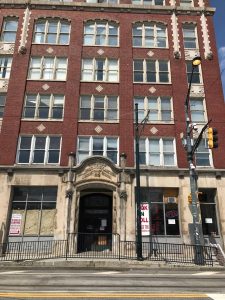
Old Fellas Building deteriorating and abandoned
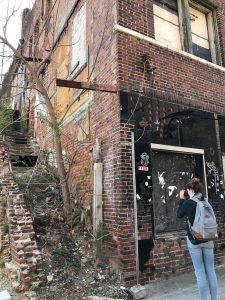
Completely Abandoned and destroyed building in the non gentrified area
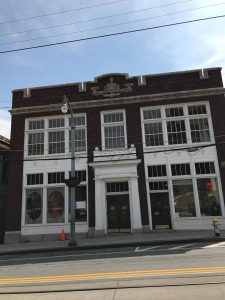
Building at the gentrified area, competely renovated and well kept
Something that really caught my attention was the conditions of some of the buildings we saw, and how the place they were situated in influenced this. The first picture shows the Old Fellas building , which is closer to the MLK historic part, and in itself is a historically important building. It’s been somewhat kept stable, given that it’s a landmark, but it’s completely abandoned and starting to deteriorate. Personally, I think the building could be put to use without having to actually take it down, for which I believe gentrification should not take over the place but rather help restore it and keep it in place working. The second building was completely destroyed and abandoned, and could be found between the historic area and the gentrified one. In itself, this building has no use, and if it was a historic one it should be kept in much better conditions, and I think that these are instances were gentrification can take over and make something useful of the space and take down the building. The last picture is from a building in the gentrified area, which is both historic and a musuem, and shows how gentrification preserved the building and kept its heritage in place. From this comparison I concluded that gentrification, if done in sync with the historical value of the place, can bring a positive outcome.
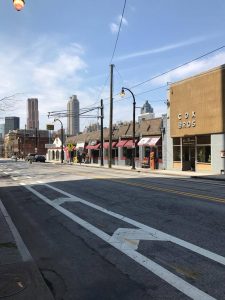
Non-Gentrified area with local businesses and old buildings
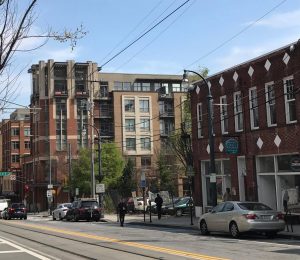
Gentrified area with newer buildings and shops
As I mentioned before, I noticed how gentrification works as a process and takes time and effort to happen. It can be seent that the gentrified area is the one closest to GA State and Midtown, and the road changes the farther you go away from the MLK historic part. In the first picture we can see the buidlings and stores along the road in the non-gentrified area. They seem to be local and small businesses, and although the buildings seem well kept, they have traces of older architecture such as the type of rooftops. Moreover, the stores were filled with local people from Auburn Av who are actually part of the community. In contrast, the second picture shows the buildings and shops along the gentrified area. We can see that the architecture is much more modern and in better conditions. Instead of local small businesses, the buildings were luxury apartments, trendy coffee shops, chain restaurants, hair salons, etc. This gave me a concious insight into the indicators of gentrification, which emcopass the common changes that appear when a place is gentrified. It was interesting to compare how different the areas were, even though it was the same street and both places were five minutes away walking from each other.